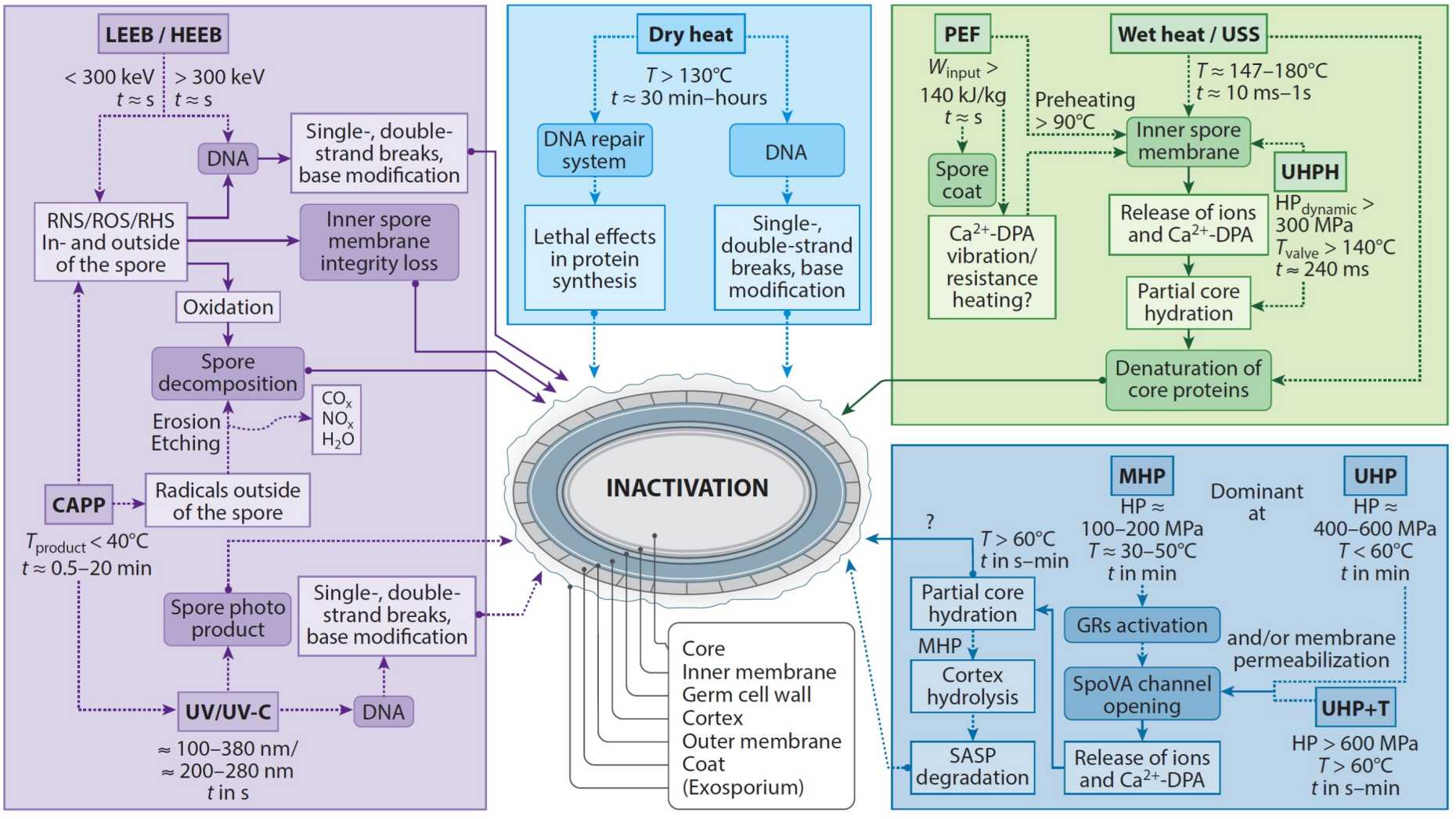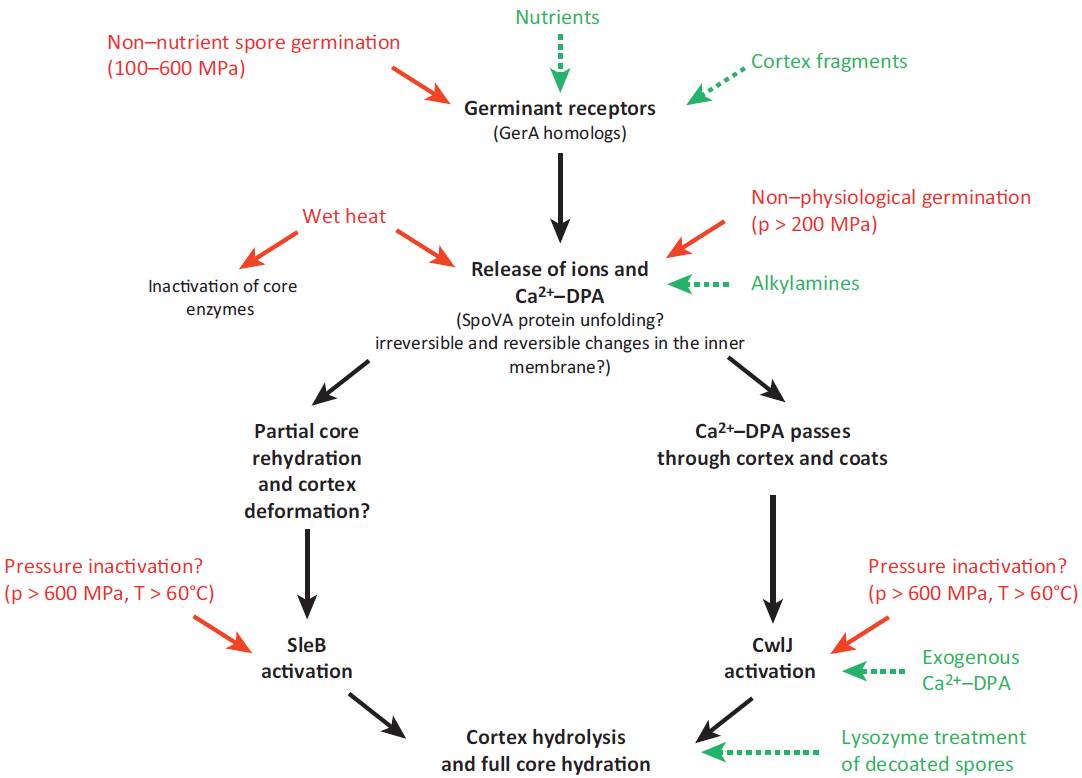Bacterial Spore Mechanisms
Overview of target structures and inactivation mechanisms observed in Bacillus and Geobacillus spores by different physical technologies: high pressure (HP), moderate high pressure (MHP), ultra-high pressure (UHP), ultra-high pressure combined with temperature (UHP+T), ultra-short sterilization (USS), ultra-high-pressure homogenization (UHPH), pulsed electric field (PEF), low-energy electron beam (LEEB), high-energy electron beam (HEEB), ultraviolet (UV) light, and cold atmospheric pressure plasma (CAPP). Solid arrows indicate joined pathways, and dashed arrows indicate individual pathways. Main target structures are shown in filled round shaped boxes. Abbreviations: DPA, dipicolinic acid; GRs, nutrient germination receptors; RHS, reactive hydrogen species; RNS, reactive nitrogen species; ROS, reactive oxygen species; SASP, small acid-soluble protein; spoVA, proteins that are encoded by the spoVA operon, which participates in channel formation in the inner membrane. (Reineke K. & Mathys A. 2020. Endospore Inactivation by Emerging Technologies: A Review on Target Structures and Inactivation Mechanisms. Annual Review of Food Science and Technology, 11. external pageDOIcall_made)
Bacterial spore control strategies based on the germination-inactivation principle can lower the thermal load needed to inactivate bacterial spores and thus preserve food quality better. However, the success of this strategy highly depends on the germination of spores, and a subpopulation of spores that fail to germinate or germinate extremely slowly hinders the application of this strategy. This subpopulation of spores is termed ‘superdormant (SD) spores’. Depending on the source of the germination stimulus, SD spores are categorized as nutrient-SD spores, Ca2+-dipicolinic acid SD spores, dodecylamine-SD spores, and high pressure SD spores. In recent decades, research has been done to isolate these different groups of SD spores and unravel the cause of their germination deficiency as well as their germination capacities. This review summarizes the challenges caused by SD spores, their isolation and characterization, the underlying mechanisms of their germination deficiency, and the future research directions needed to tackle this topic in further depth. (Zhang Y. & Mathys A. 2019. Superdormant spores as a hurdle for gentle germination-inactivation based spore control strategies. Frontiers in Microbiology.9:3163. external pageDOIcall_made)
Selected publications
Reineke K. & Mathys A. (2020). Endospore Inactivation by Emerging Technologies: A Review on Target Structures and Inactivation Mechanisms. Annual Review of Food Science and Technology, 11. external pageDOIcall_made
Zhang Y. & Mathys A. (2019). Superdormant spores as a hurdle for gentle germination-inactivation based spore control strategies. Frontiers in Microbiology.9:3163. external pageDOIcall_made
Heydenreich, R., Delbrück, A. I., Trunet, C. & Mathys, A. (2023). Post-high-pressure temperature and time — Overlooked parameters in high pressure treatment of bacterial spores. International Journal of Food Microbiology, vol. 402, pp. 110279, external pageDOIcall_made
Delbrück, A. I., Tritten Y., Nanni P., Heydenreich, R. & Mathys, A. (2022). Moderate high-pressure superdormancy in Bacillus spores: properties of superdormant spores and proteins potentially influencing moderate high-pressure germination. Applied and Environmental Microbiology. external pageDOIcall_made
Delbrück, A. I., Zhang, Y., Heydenreich, R. & Mathys, A. (2021). Bacillus spore germination at moderate high pressure: A review on underlying mechanisms, influencing factors, and its comparison with nutrient germination. Comprehensive Reviews in Food Science and Food Safety. external pageDOIcall_made
Delbrück, A. I., Zhang, Y., Hug, V., Trunet, C. & Mathys, A. (2021). Isolation, stability, and characteristics of high-pressure superdormant Bacillus subtilis spores. International Journal of Food Microbiology, 343- 109088. external pageDOIcall_made
Zhang Y., Huber N., Moeller R., Stülke J., Dubovcova B., Akepsimaidis G., Meneses N., Drissner D. and Mathys A. (2020). Role of DNA repair in Bacillus subtilis spore resistance to high energy and low energy electron beam treatments. Food Microbiology 87: 103353. external pageDOIcall_made
Zhang Y., Delbrück A.I., Off C.L., Benke S. & Mathys A. (2020). Flow Cytometry Combined with Single Cell Sorting to Study Heterogeneous Germination of Bacillus Spores under High Pressure. Frontiers in Microbiology, vol. 10, pp. 3118 . external pageDOIcall_made
Mathys A., Reineke R. & Jaeger H. (2019). Editorial: Microbial decontamination by novel technologies – Mechanisms and application concepts. Frontiers in Microbiology 10:1476. external pageDOIcall_made
Zhang Y., Moeller R., Tran S., Dubovcova B., Akepsimaidis G., Meneses N., Drissner D. and Mathys A. (2018). Geobacillus and Bacillus spore inactivation by low energy electron beam technology: Resistance and influencing factors. Frontiers in Microbiology, 9:2720. external pageDOIcall_made
Dong P., Georget E., Aganovic K., Heinz V. & Mathys A. (2015).Ultra high pressure homogenization (UHPH) inactivation of Bacillus amyloliquefaciens spores in phosphate buffered saline (PBS) and milk. Frontiers in Microbiology, 6, 712.
Georget E., Kapoor S., Winter R., Reineke K., Song Y., Callanan M., Ananta E., Heinz V. & Mathys A. (2014).In situ investigation of G. stearothermophilus spore germination&inactivation mechanisms under moderate high pressure.Food Microbiology, 41, 8-18.
Georget E., Kushman A., Callanan M., Ananta E., Heinz V. & Mathys A. (2014).Geobacillus stearothermophilus ATCC 7953 spores chemical germination mechanisms in model systems. Food Control, 50, 141-149.
Georget E., Miller B., Aganovic K., Callanan M., Heinz V. & Mathys A. (2014).Bacterial spore inactivation by ultra-high pressure homogenization. Innovative Food Science and Emerging Technologies, 26, 116–123.
Georget E., Miller B., Callanan M., Heinz V. & Mathys A. (2014).(Ultra) high pressure homogenization for continuous high pressure sterilization of pumpable foods - a review. Frontiers in Nutrition, 1(15), 1-6.
Georget E., Sevenich R., Reineke K., Mathys A., Heinz V., Callanan M., Rauh C. & Knorr D. (2014).Inactivation of micro organism by high pressure processing in complex matrices:a review.Innovative Food Science&Emerging Technologies, 27, 1-14.
Reineke K., Mathys A., Heinz V. & Knorr D. (2013).
Mechanisms of endospore inactivation under high pressure. Trends in Microbiology, 21(6), 296-304.
Reineke K., Ellinger N., Berger D., Baier D., Mathys A., Setlow P. & Knorr D. (2013).Structural analysis of high pressure treated Bacillus subtilis spores. Innovative Food Science & Emerging Technologies, 17, 43–53.
Reineke K., Schlumbach K., Baier D., Mathys A. & Knorr D. (2013).The release of dipicolinic acid-The rate-limiting step of Bacillus endospore inactivation during the high pressure thermal sterilization process. Int.Journal of Food Microbiology, 162, 55-63.
Reineke K., Doehner I., Schlumbach K., Baier D., Mathys A. & Knorr D. (2011).The different pathways of spore germination and inactivation in dependence of pressure and temperature. Innovative Food Science and Emerging Technologies, 13, 31-41.
Reineke K., Mathys A. & Knorr D. (2011).Shift of pH-value during thermal treatments in buffer solutions and selected foods. International Journal of Food Properties, 14(4), 870-881.
Baier D., Reineke K., Doehner I., Mathys A. & Knorr D. (2010).Fluorescence-based methods for the detection of pressure-induced spore germination and inactivation. High Pressure Research, 31(1), 110-115.
Mathys A., Kallmeyer R., Heinz V. & Knorr D. (2008).Impact of dissociation equilibrium shift on bacterial spore inactivation by heat and pressure. Food Control, 19(12), 1165-1173.
Mathys A., Chapman B., Bull M., Heinz V. & Knorr D. (2007).Flow cytometric assessment of Bacillus spore response to high pressure and heat. Innovative Food Science and Emerging Technologies, 8(4), 519–527.


